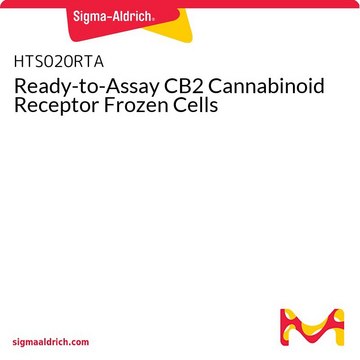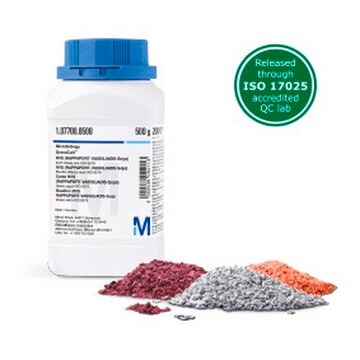17-10219
LentiBrite GFP-Cortactin Lentiviral Biosensor
Iniciar sesiónpara Ver la Fijación de precios por contrato y de la organización
About This Item
UNSPSC Code:
41106621
eCl@ss:
34360190
NACRES:
NA.32
Productos recomendados
General description
Cortactin is a key mediator of cell migration and invasion that localizes to the actin-rich structures lamellipodia, invadopodia and podosomes, where it promotes the formation and maintains the stability of branched actin networks. By virtue of its multidomain structure, cortactin also interacts with a diverse array of cytoskeleton regulators and signaling proteins. Fluorescent proteins fused to cortactin have been employed in live cells to monitor the dynamics of invadopodia formation.
EMD Millipore′s LentiBrite GFP-cortactin lentiviral particles provide bright fluorescence and precise localization to enable live cell analysis of invadopodia and lamellipodia in difficult-to-transfect cell types.
EMD Millipore′s LentiBrite GFP-cortactin lentiviral particles provide bright fluorescence and precise localization to enable live cell analysis of invadopodia and lamellipodia in difficult-to-transfect cell types.
Application
Fluorescence microscopy imaging:
Human skin melanoma cells, RPMI-7951 were plated in a gelatin-coated chamber slide and transduced with lentiviral particles at an MOI of 20 for 24 hours. After media replacement and 24 hours further incubation, cells were fixed with formaldehyde and mounted. Images were obtained by oil immersion wide-field fluorescence microscopy. The GFP-Cortactin localizes most prominently to protrusions at the cell periphery consistent with lamellipodia.
Immunocytochemistry Comparison:
Human breast adenocarcinoma cells, MDA-MB-231, were plated in a gelatin-coated chamber slide and transduced with lentiviral particles at an MOI of 10 for 24 hours. After 24 hours, media was replaced and cells were then further incubated for 24 hours. Similar expression patterns are observed for GFP-cortactin and immunocytochemical staining with a monoclonal antibody against cortactin conjugated with Alexa Fluor 555 (EMD Millipore Cat No. 16-229).
Various Invasive Cell Types:
Mouse peitoneal macrophage cells, IC21 or human skin non-invasive melanoma cells, SK-MEL-28 were plated in gelatin-coated chamber slides and transduced with lentiviral particles at an MOI of 20 for 24 hours.
Human skin melanoma cells, RPMI-7951 were plated in a gelatin-coated chamber slide and transduced with lentiviral particles at an MOI of 20 for 24 hours. After media replacement and 24 hours further incubation, cells were fixed with formaldehyde and mounted. Images were obtained by oil immersion wide-field fluorescence microscopy. The GFP-Cortactin localizes most prominently to protrusions at the cell periphery consistent with lamellipodia.
Immunocytochemistry Comparison:
Human breast adenocarcinoma cells, MDA-MB-231, were plated in a gelatin-coated chamber slide and transduced with lentiviral particles at an MOI of 10 for 24 hours. After 24 hours, media was replaced and cells were then further incubated for 24 hours. Similar expression patterns are observed for GFP-cortactin and immunocytochemical staining with a monoclonal antibody against cortactin conjugated with Alexa Fluor 555 (EMD Millipore Cat No. 16-229).
Various Invasive Cell Types:
Mouse peitoneal macrophage cells, IC21 or human skin non-invasive melanoma cells, SK-MEL-28 were plated in gelatin-coated chamber slides and transduced with lentiviral particles at an MOI of 20 for 24 hours.
Different cell types demonstrate various range of degration patterns that may be observed due to invadopodia or podosome formation. Localized areas of concentration of GFP-cortactin were observed in IC21 cells, while the non-invasive melanoma SK-MEL-28 cells displayed weaker and diffuse cortactin expression.
For optimal fluorescent visualization, it is recommended to analyze the target expression level within 24-48 hrs after transfection/infection for optimal live cell analysis, as fluorescent intensity may dim over time, especially in difficult-to-transfect cell lines. Infected cells may be frozen down after successful transfection/infection and thawed in culture to retain positive fluorescent expression beyond 24-48 hrs. Length and intensity of fluorescent expression varies between cell lines. Higher MOIs may be required for difficult-to-transfect cell lines.
For optimal fluorescent visualization, it is recommended to analyze the target expression level within 24-48 hrs after transfection/infection for optimal live cell analysis, as fluorescent intensity may dim over time, especially in difficult-to-transfect cell lines. Infected cells may be frozen down after successful transfection/infection and thawed in culture to retain positive fluorescent expression beyond 24-48 hrs. Length and intensity of fluorescent expression varies between cell lines. Higher MOIs may be required for difficult-to-transfect cell lines.
Components
TagGFP2-Cortactin Lentivirus: One vial containing 25 µL of lentiviral particles at a minimum of 3 x 10E8 infectious units (IFU) per mL. For lot-specific titer information, please see “Viral Titer” in the datasheet. Promoter EF-1 (Elongation Factor-1) Multiplicty of Infection (MOI) MOI = Ratio of # of infectious lentiviral particles (IFU) to # of cells being infected. Typical MOI values for high transduction efficiency and signal intensity are in the range of 20-40. For this target, some cell types may require lower MOIs (e.g., HT-1080, HeLa, U2OS, human mesenchymal stem cells (HuMSC)), while others may require higher MOIs (e.g., human umbilical vein endothelial cells (HUVEC)). NOTE: MOI should be titrated and optimized by the end user for each cell type and lentiviral target to achieve desired transduction efficiency and signal intensity.
Quality
Evaluated by transduction of HT-1080 cells. Fluorescent imaging performed for assessment of target localization and transduction efficiency.
Storage and Stability
Storage and HandlingLentivirus is stable for at least 4 months from date of receipt when stored at -80°C. After first thaw, place immediately on ice and freeze in working aliquots at -80°C. Frozen aliquots may be stored for at least 2 months. Further freeze/thaws may result in decreased virus titer and transduction efficiency. IMPORTANT SAFETY NOTEReplication-defective lentiviral vectors, such as the 3rd Generation vector provided in this product, are not known to cause any diseases in humans or animals. However, lentiviruses can integrate into the host cell genome and thus pose some risk of insertional mutagenesis. Material is a Risk Group 2 and should be handled under BSL2 controls. A detailed discussion of biosafety of lentiviral vectors is provided in Pauwels, K. et al. (2009). State-of-the-ART® lentiviral vectors for research use: Risk assessment and biosafety recommendations. Curr. Gene Ther. 9: 459-474.
Legal Information
ART is a registered trademark of Molecular BioProducts, Inc.
Disclaimer
This product contains genetically modified organisms (GMO). Within the EU GMOs are regulated by Directives 2001/18/EC and 2009/41/EC of the European Parliament and of the Council and their national implementation in the member States respectively. This legislation obliges {HCompany} to request certain information about you and the establishment where the GMOs are being handled. Click here for Enduser Declaration (EUD) Form.Unless otherwise stated in our catalog or other company documentation accompanying the product(s), our products are intended for research use only and are not to be used for any other purpose, which includes but is not limited to, unauthorized commercial uses, in vitro diagnostic uses, ex vivo or in vivo therapeutic uses or any type of consumption or application to humans or animals.
Storage Class
10 - Combustible liquids
wgk_germany
WGK 2
Certificados de análisis (COA)
Busque Certificados de análisis (COA) introduciendo el número de lote del producto. Los números de lote se encuentran en la etiqueta del producto después de las palabras «Lot» o «Batch»
¿Ya tiene este producto?
Encuentre la documentación para los productos que ha comprado recientemente en la Biblioteca de documentos.
Nuestro equipo de científicos tiene experiencia en todas las áreas de investigación: Ciencias de la vida, Ciencia de los materiales, Síntesis química, Cromatografía, Analítica y muchas otras.
Póngase en contacto con el Servicio técnico

![[1,1′-Bis(diphenylphosphino)ferrocene]dichloropalladium(II)](/deepweb/assets/sigmaaldrich/product/structures/130/734/8846aa26-1858-458a-998d-8c306c13bf0f/640/8846aa26-1858-458a-998d-8c306c13bf0f.png)




![[1,1′-bis(difenilfosfino)ferroceno]dicloropaladio(II), complejo con diclorometano](/deepweb/assets/sigmaaldrich/product/structures/825/986/4317978b-1256-4c82-ab74-6a6a3ef948b1/640/4317978b-1256-4c82-ab74-6a6a3ef948b1.png)